Genetic Algorithm-Based Optimisation of a Double-Wall Effusion Cooling System for a High-Pressure Turbine Nozzle Guide Vane †
Abstract
:1. Introduction
2. Related Work
2.1. Double-Wall Effusion Cooling Systems
2.2. Flow Networks
2.3. Genetic Algorithm Optimisation
3. Low-Order Modelling Methodology
- The Continuity Network solves for mass flow continuity through the fluid domain by evaluating static pressure at each node. The mass flow from inlet node to outlet node is dependent only on the pressure difference , the fluid density at inlet , and the link’s mass flow compliance .
- The Energy Network solves for energy conservation throughout both the fluid and solid domains. For fluid nodes, this requires balancing flow enthalpy (dependent on the flow’s inlet temperature ) and heat transfer from the solid. The heat transfer from fluid node to solid node is dependent only on the temperature difference and the link’s heat transfer rate .
4. Computational Fluid Dynamics Methodology
5. Optimisation Objective and Methodology
- Minimise Total Coolant Mass Flow .
- Ensure Minimum Metal Cooling Effectiveness (19) of 0.44.
- Ensure a (1) of at least 1.0015 for each film hole.
6. Results and Discussion
7. Conclusions
Author Contributions
Funding
Data Availability Statement
Acknowledgments
Conflicts of Interest
Nomenclature
| Area | |
| Backflow Pressure Margin | |
| Lateral Film Cooling Decay Factor | |
| Discharge Coefficient | |
| Cross-Flow Correction Factor | |
| Diameter | |
| Friction Factor | |
| Heat Transfer Coefficient | |
| Height | |
| Thermal Conductivity | |
| Pressure Loss Coefficient | |
| Length | |
| Leading Edge | |
| Mass Flow Rate | |
| Blowing Ratio | |
| Nusselt Number | |
| Nozzle Guide Vane | |
| Pressure | |
| Pressure Surface | |
| Prandtl Number | |
| Heat Transfer Rate | |
| Radius | |
| Reynolds Number | |
| Suction Surface | |
| Temperature | |
| Trailing Edge | |
| Turbine Entry Temperature | |
| Velocity | |
| Streamwise Distance | |
| Film Cooling Streamwise Decay Factor | |
| Spanwise Distance | |
| Turbulent Thermal Diffusivity | |
| Area Ratio | |
| Expansibility Factor | |
| Overall Cooling Effectiveness | |
| Effectiveness or Efficiency | |
| Density | |
| Subscripts | |
| Total | |
| Average | |
| Adiabatic Wall | |
| Coolant | |
| Conductive | |
| Convective | |
| Exit | |
| Exterior | |
| Film/Effusion | |
| Film/Effusion Wall | |
| Hydraulic | |
| Impingement | |
| Impingement Wall | |
| Inlet | |
| Interior | |
| Metal | |
| Maximum | |
| Minimum | |
| Pedestal | |
| Surface | |
| Turning | |
| Mainstream | |
References
- van de Noort, M.; Ireland, P.T. Genetic Algorithm Based Optimisation of a Double-Wall Effusion Cooling System for a High-Pressure Turbine Nozzle Guide Vane. In Proceedings of the 15th European Conference on Turbomachinery Fluid Dynamics & Thermodynamics, Budapest, Hungary, 24–28 April 2023. [Google Scholar]
- Thurman, D.; Poinsatte, P.; Ameri, A.; Culley, D.; Raghu, S.; Shyam, V. Investigation of Spiral and Sweeping Holes. J. Turbomach. 2016, 138, 091007. [Google Scholar] [CrossRef] [PubMed]
- Elmukashfi, E.; Murray, A.V.; Ireland, P.T.; Cocks, A.C.F. Analysis of the Thermomechanical Stresses in Double-Wall Effusion Cooled Systems. J. Turbomach. 2019, 142, 051002. [Google Scholar] [CrossRef]
- Skamniotis, C.; Courtis, M.; Cocks, A.C. Multiscale analysis of thermomechanical stresses in double wall transpiration cooling systems for gas turbine blades. Int. J. Mech. Sci. 2021, 207, 106657. [Google Scholar] [CrossRef]
- AMurray, A.V.; Ireland, P.T.; Rawlinson, A.J. An Integrated Conjugate Computational Approach for Evaluating the Aerothermal and Thermomechanical Performance of Double-Wall Effusion Cooled Systems. In Proceedings of the ASME Turbo Expo 2017, Turbomachinery Technical Conference and Exposition, Charlotte, NC, USA, 26–30 June 2017. [Google Scholar]
- van de Noort, M.; Ireland, P. A Low Order Flow Network Model for Double-Wall Effusion Cooling Systems. Int. J. Turbomach. Propuls. Power 2022, 7, 5. [Google Scholar] [CrossRef]
- van de Noort, M.; Murray, A.V.; Ireland, P.T. Low Order Heat & Mass Flow Network Modelling for Quasi-Transpiration Cooling Systems. In Proceedings of the ASME Turbo Expo 2022: Turbomachinery Technical Conference and Exposition, Rotterdam, The Netherlands, 13–17 June 2022. [Google Scholar]
- Lytle, D.; Webb, B.W. Air jet impingement heat transfer at low nozzle-plate spacings. Int. J. Heat Mass Transf. 1994, 12, 1687–1697. [Google Scholar] [CrossRef]
- San, J.Y.; Shiao, W.Z. Effects of jet plate size and plate spacing on the stagnation Nusselt number for a confined circular air jet impinging on a flat surface. Int. J. Heat Mass Transf. 2006, 49, 3477–3486. [Google Scholar] [CrossRef]
- Andrews, G.E.; Asere, A.A.; Hussain, C.I.; Mkpadi, M.C. Full Coverage Impingement Heat Transfer: The Variation in Pitch to Diameter Ratio at a Constant Gap. In Proceedings of the 65th Symposium, Heat Transfer and Cooling in Gas Turbines, Bergen, Norway, 6–10 May 1985. [Google Scholar]
- Chyu, M.K.; Hsing, Y.C.; Natarajan, V. Convective Heat Transfer of Cubic Fin Arrays in a Narrow Channel. J. Turbomach. 1998, 120, 363–367. [Google Scholar] [CrossRef]
- Murray, A.V.; Ireland, P.T.; Wong, T.H.; Tang, S.W.; Rawlinson, A.J. High Resolution Experimental and Computational Methods for Modelling Multiple Row Effusion Cooling Performance. Int. J. Turbomach. Propuls. Power 2018, 3, 4. [Google Scholar] [CrossRef]
- Wambersie, A.; Wong, H.; Ireland, P.; Mayo, I. Experiments of Transpiration Cooling Inspired Panel Cooling on a Turbine Blade Yielding Film Effectiveness Levels over 95%. Int. J. Turbomach. Propuls. Power 2021, 6, 16. [Google Scholar] [CrossRef]
- Courtis, M.; Murray, A.; Coulton, B.; Ireland, P.; Mayo, I. Influence of Spanwise and Streamwise Film Hole Spacing on Adiabatic Film Effectiveness for Effusion-Cooled Gas Turbine Blades. Int. J. Turbomach. Propuls. Power 2021, 6, 37. [Google Scholar] [CrossRef]
- Courtis, M.; Ireland, P. Influence of Porosity on Double-Walled Effusion-Cooled Systems for Gas Turbine Blades. In Proceedings of the ASME Turbo Expo 2022: Turbomachinery Technical Conference and Exposition, Rotterdam, The Netherlands, 13–17 June 2022. [Google Scholar]
- Jackowski, T.; Elfner, M.; Bauer, H.J. Experimental Study of Impingement Effusion-Cooled Double-Wall Combustor Liners: Thermal Analysis. Energies 2021, 14, 4843. [Google Scholar] [CrossRef]
- Rose, J.R. NASA TM-73774: FLOWNET: A Computer Program for Calculating Secondary Flow Conditions in a Newtork of Turbomachinery; NASA: Cleveland, OH, USA, 1978.
- Kutz, K.J.; Speer, T.M. Simulation of the Secondary Air System of Aero Engines. In Proceedings of the ASME 1992 International Gas Turbine and Aeroengine Congress and Exposition, Cologne, Germany, 1–4 June 1992. [Google Scholar]
- Ebenhoch, G.; Speer, T.M. Simulation of Cooling Systems in Gas Turbines. In Proceedings of the ASME 1994 International Gas Turbine and Aeroengine Congress and Exposition, The Hague, The Netherlands, 13–16 June 1994. [Google Scholar]
- Jin, H.; Riddle, A.; Cooke, L. A Compressible Flow Network Analysis for Design Upgrade of Industrial Aeroderivative High Pressure Turbine Blades. In Proceedings of the ASME Turbo Expo 2008: Power for Land, Sea, and Air, Berlin, Germany, 9–13 June 2008. [Google Scholar]
- Muller, S.D.; Walther, J.H.; Koumoutsakos, P.D. Evolution strategies for film cooling optimization. AIAA J. 2011, 39, 537–539. [Google Scholar] [CrossRef]
- Johnson, J.J.; King, P.I.; Clark, J.P. Low-Heat-Load-Vane Profile Optimization, Part 1: Code Validation and Airfoil Design. J. Propuls. Power 2008, 24, 395–402. [Google Scholar] [CrossRef]
- Johnson, J.J.; King, P.I.; Clark, J.P.; Ooten, M.K. Genetic algorithm optimization of a high-pressure turbine vane pressure side film cooling array. J. Turbomach. 2014, 136, 011011. [Google Scholar] [CrossRef]
- Mazzei, L.; Winchler, L.; Andreini, A. Development of a numerical correlation for the discharge coefficient of round inclined holes with low crossflow. Comput. Fluids 2017, 152, 182–192. [Google Scholar] [CrossRef]
- Gritsch, M.; Schulz, A.; Wittig, S. Effect of crossflows on the discharge coefficient of film cooling holes with varying angles of inclination and orientation. In Proceedings of the ASME Turbo Expo: Power for Land, Sea, and Air, New Orleans, LA, USA, 4–7 June 2001. [Google Scholar]
- Gillespie, D.R.H. Intricate Internal Cooling Systems for Gas Turbine Blading. Ph.D. Thesis, University of Oxford, Oxford, UK, 1996. [Google Scholar]
- Howatson, A.M.; Lund, P.G.; Todd, J.D. Engineering Tables and Data, Oxford: Department of Engineering Science; University of Oxford: Oxford, UK, 2009. [Google Scholar]
- Goldstein, R. Film Cooling. Adv. Heat Transf. 1971, 7, 321–379. [Google Scholar]
- Sellers, J.P. Gaseous Film Cooling with Multiple Injection Stations. AIAA J. 1963, 9, 2154–2156. [Google Scholar] [CrossRef]
- Ambrok, G.S. Approximate solution of equations for the thermal boundary layer with variations in boundary layer structure. Sov. Phys.—Tech. Phys. 1957, 2, 1979–1986. [Google Scholar]
- Kays, W.M.; Crawford, M.E. Convective Heat and Mass Transfer; McGraw-Hill: New York, NY, USA, 1980. [Google Scholar]
- Holgate, N.E.; Cresci, I.; Ireland, P.T.; Rawlinson, A. Prediction and Augmentation of Nozzle Guide Vane Film Cooling Hole Pressure Margin. In Proceedings of the 12th European Conference on Turbomachinery Fluid Dynamics & Thermodynamics, Stockholm, Sweden, 3–7 April 2017. [Google Scholar]
- MathWorks. How the Genetic Algorithm Works. 2022. Available online: https://uk.mathworks.com/help/gads/how-the-genetic-algorithm-works.html (accessed on 7 April 2022).
- Wang, S.; Jian, G.; Xiao, J.; Wen, J.; Zhang, Z. Optimization investigation on configuration parameters of spiral-wound heat exchanger using Genetic Aggregation response surface and Multi-Objective Genetic Algorithm. Appl. Therm. Eng. 2017, 119, 603–609. [Google Scholar] [CrossRef]
- Bunker, R.S. The Effects of Manufacturing Tolerances on Gas Turbine Cooling. ASME J. Turbomach. 2009, 131, 81–96. [Google Scholar] [CrossRef]
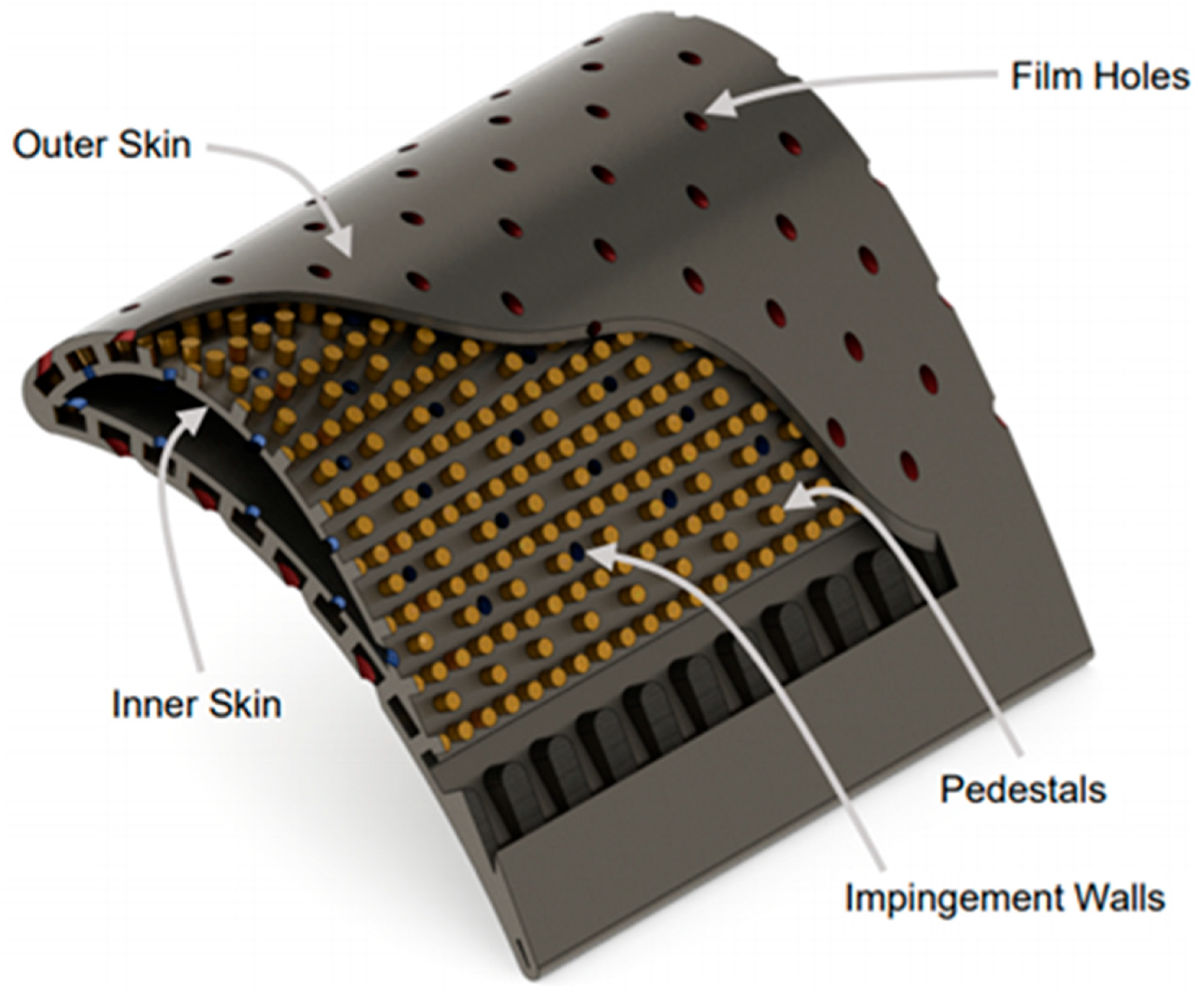
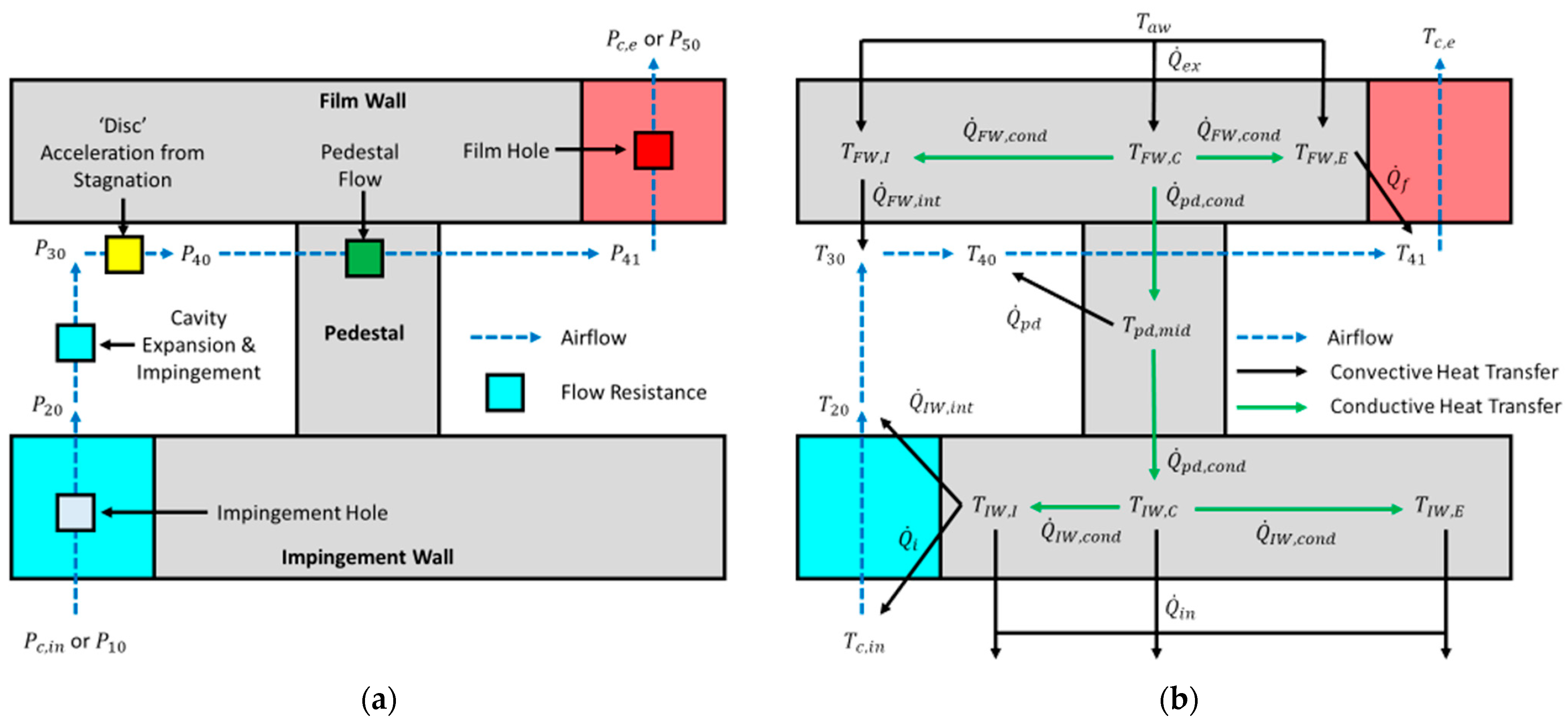
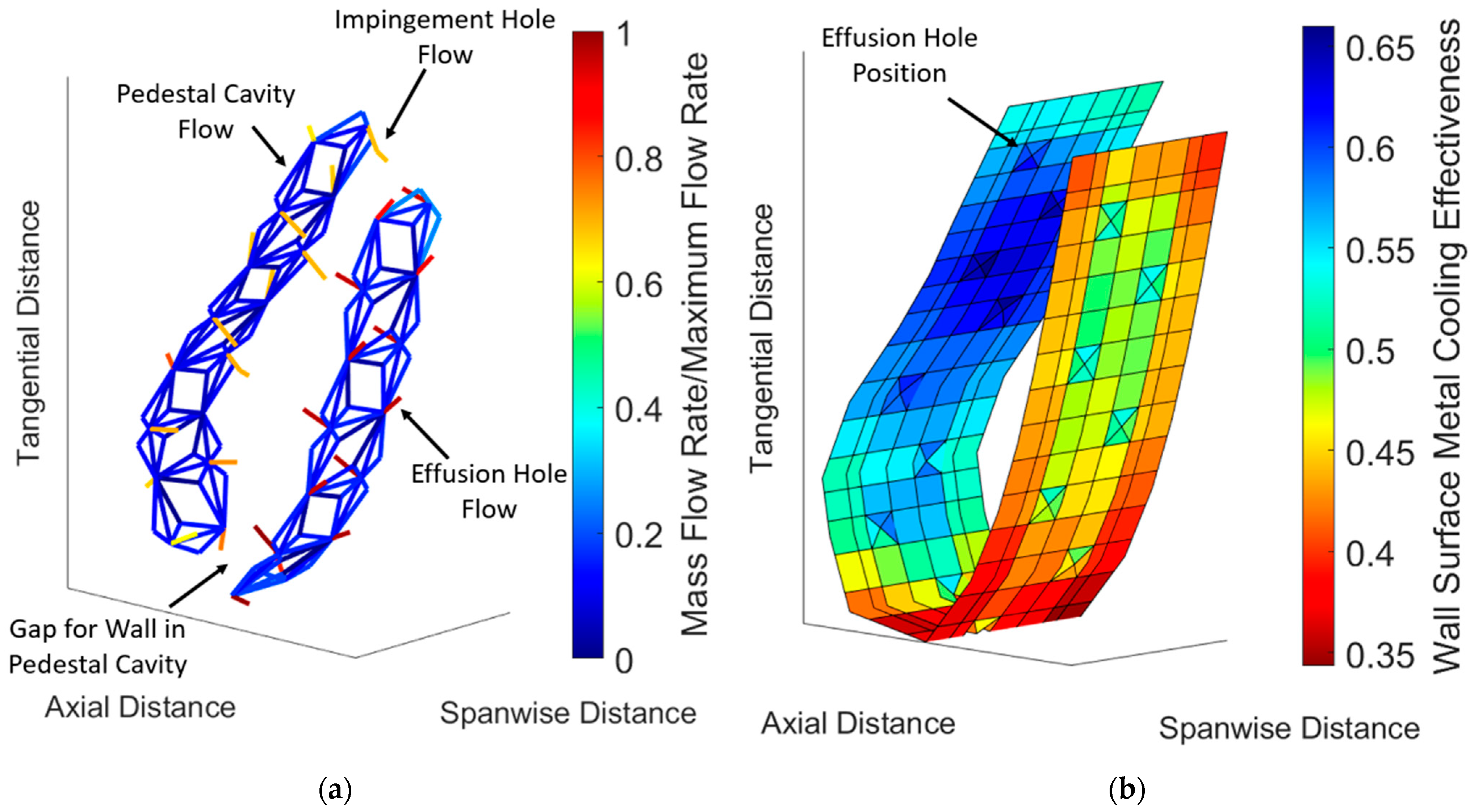
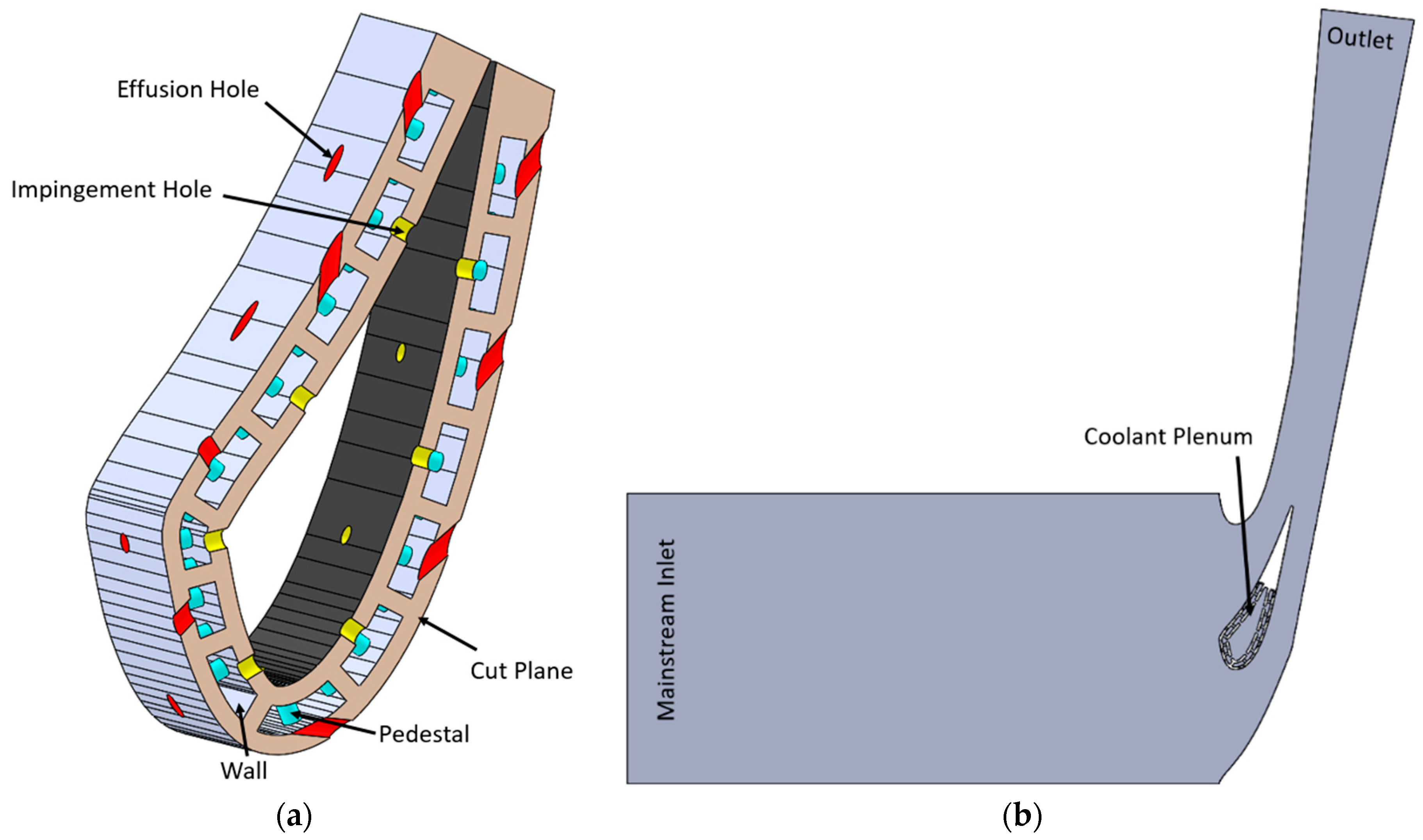
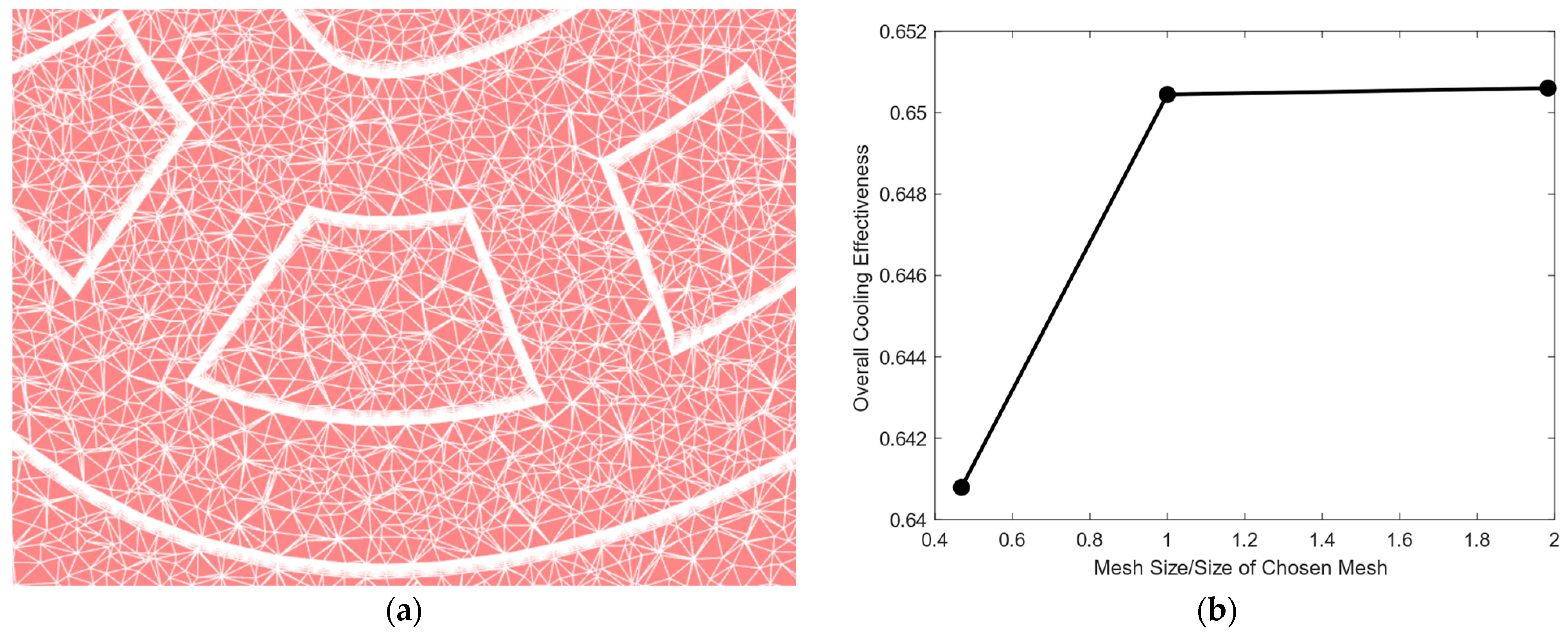
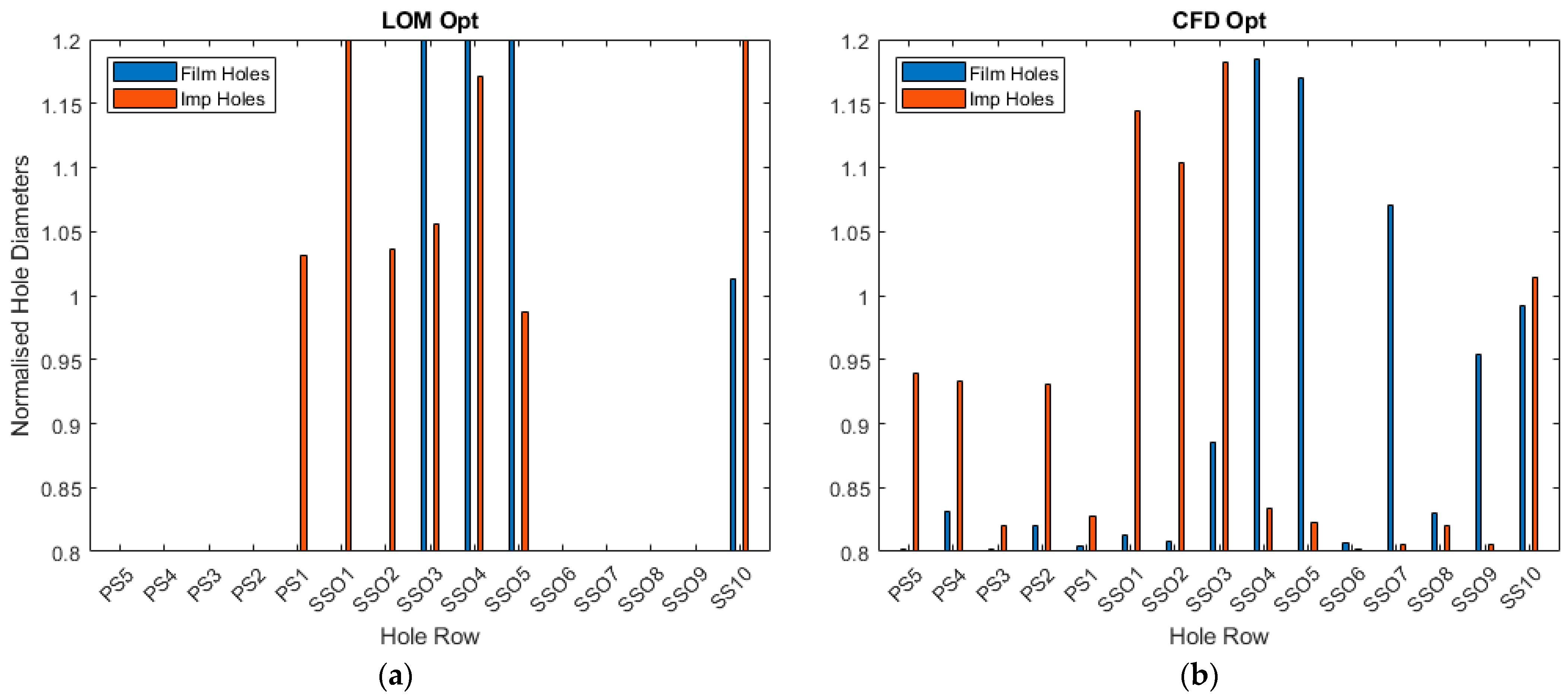
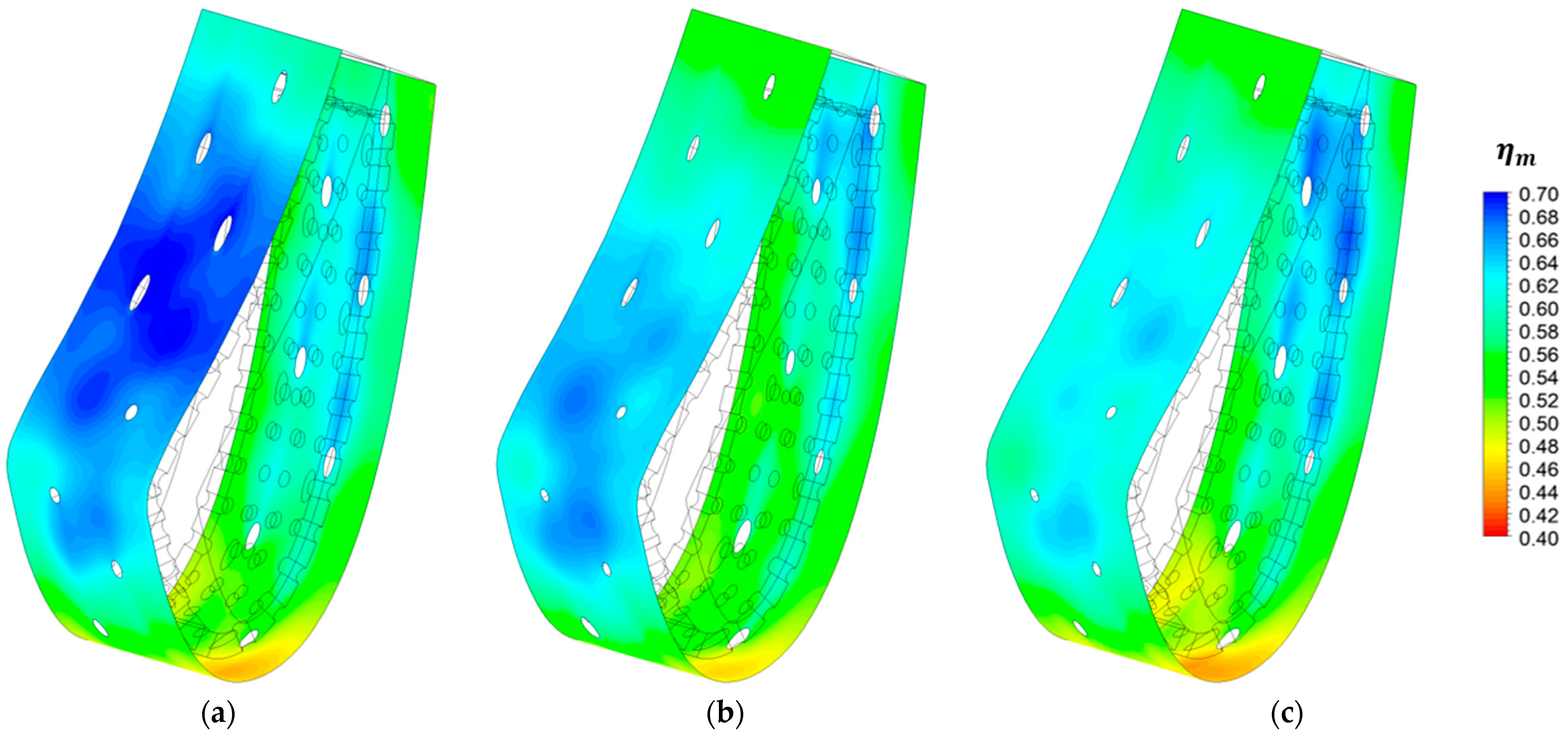
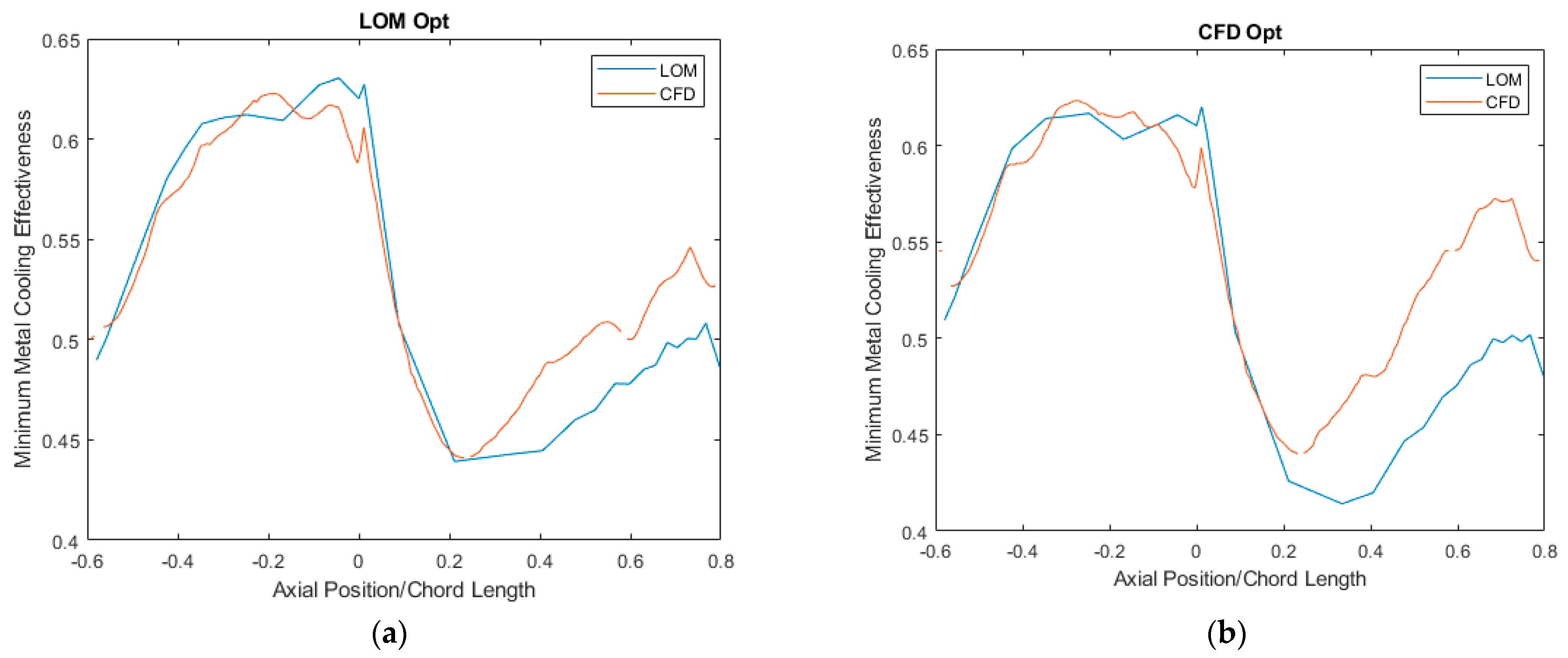
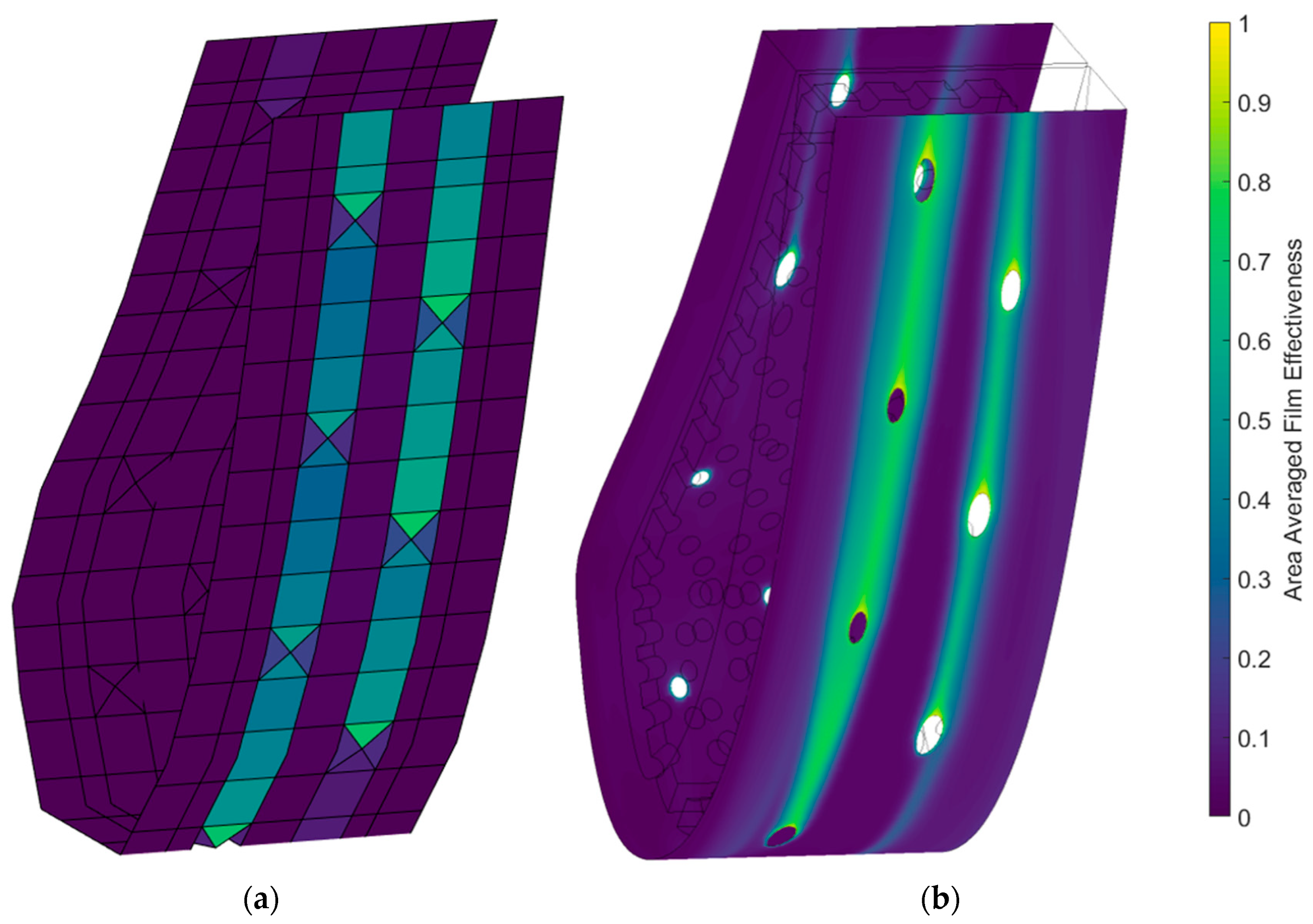

| Link | Mass Flow Equation | Eq. Ref. |
|---|---|---|
| 10 → 20 | (2) | |
| 20 → 30 | (3) | |
| 30 → 40 | (4) | |
| 40 → 41 | (5) | |
| 41 → 50 | (6) |
| Surface | Correlation | Characteristic Length | Eq. Ref. |
|---|---|---|---|
| Film Wall, Interior | (8) | ||
| Impingement Wall, Interior | (9) | ||
| Film Hole Surface | (10) | ||
| Impingement Hole Surface | (11) | ||
| Pedestal Surface | (12) | ||
| Impingement Wall, Exterior | (13) | ||
| Film Wall, Exterior | (14) |
| Geometry | LOM Results | CFD Results | ||||
|---|---|---|---|---|---|---|
| Baseline | 0.0210 | 0.4274 | 1.0011 | 0.0210 | 0.4225 | 1.0010 |
| All Min | 0.0136 | 0.3818 | 1.0008 | 0.0129 | 0.3903 | 1.0011 |
| All Max | 0.0298 | 0.4606 | 1.0013 | 0.0311 | 0.4481 | 1.0007 |
| LOM Opt. | 0.0182 | 0.4402 | 1.0015 | 0.0182 | 0.4410 | 1.0016 |
| CFD Opt. | 0.0171 | 0.4129 | 1.0016 | 0.0165 | 0.4400 | 1.0015 |
Disclaimer/Publisher’s Note: The statements, opinions and data contained in all publications are solely those of the individual author(s) and contributor(s) and not of MDPI and/or the editor(s). MDPI and/or the editor(s) disclaim responsibility for any injury to people or property resulting from any ideas, methods, instructions or products referred to in the content. |
© 2024 by the authors. Licensee MDPI, Basel, Switzerland. This article is an open access article distributed under the terms and conditions of the Creative Commons Attribution (CC BY-NC-ND) license (https://creativecommons.org/licenses/by-nc-nd/4.0/).
Share and Cite
van de Noort, M.; Ireland, P.T. Genetic Algorithm-Based Optimisation of a Double-Wall Effusion Cooling System for a High-Pressure Turbine Nozzle Guide Vane. Int. J. Turbomach. Propuls. Power 2024, 9, 6. https://doi.org/10.3390/ijtpp9010006
van de Noort M, Ireland PT. Genetic Algorithm-Based Optimisation of a Double-Wall Effusion Cooling System for a High-Pressure Turbine Nozzle Guide Vane. International Journal of Turbomachinery, Propulsion and Power. 2024; 9(1):6. https://doi.org/10.3390/ijtpp9010006
Chicago/Turabian Stylevan de Noort, Michael, and Peter T. Ireland. 2024. "Genetic Algorithm-Based Optimisation of a Double-Wall Effusion Cooling System for a High-Pressure Turbine Nozzle Guide Vane" International Journal of Turbomachinery, Propulsion and Power 9, no. 1: 6. https://doi.org/10.3390/ijtpp9010006





